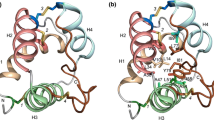Abstract
The extracellular protein EP2 was previously identified as non-specific lipid transfer protein based on its cDNA-derived amino acid sequence. Here, the purification of the EP2 protein from the medium of somatic embryo cultures is described. After two cycles of ion-exchange and gel permeation chromatography, a single silver-stained protein band with an apparent molecular mass of 10 kDa was observed on SDS-PAGE. This protein band was recognized by the antiserum raised against a EP2-β-galactosidase fusion-protein. Employing a fluorescent phospholipid analog, it was shown that the purified EP2 protein is capable of binding phospholipids and is able to enhance their transfer between artificial membranes. Employing a gel permeation assay, it could be demonstrated that the EP2 protein is also capable of binding palmitic and oleic acid as well as oleyl-CoA. Because in plants these fatty acids are used as precursor molecules for cutin, these results are in support of the proposed role of the EP2 protein to transport cutin monomers from their site of synthesis through the cell wall of epidermal cells to sites of cutin polymerization.
Similar content being viewed by others
References
Backs-Husemann D, Reinert J: Embryobildung durch isolierte Einzelzellen aus Gewebekulturen von Daucus carota. Protoplasma 70: 439–460, 1970
Nomura K, Komamine A: Identification and isolation of single cells that produce somatic embryos at a high frequency in a carrot suspension culture. Plant Physiol 79: 988–991, 1985
Halperin W: Alternative morphogenetic events in cell suspensions. Am J Bot 53: 443–453, 1966
Dudits D, Brogre L, Gyorgyey J: Molecular cellular approaches to the analysis of plant embryo development from somatic cellsin vitro. J Cell Science 99: 475–484, 1991
Sterk P, De Vries SC: Molecular markers for plant embryos. In: K Redenbaugh (ed.) SynSeeds: Application of synthetic seeds to crop improvement. CRC Press, 1992, in press
De Vries SC, Booij H, Janssens R, Vogels R, Saris L, LoSchiavo F, Terzi M, Van Kammen A: Carrot somatic embryogenesis depends on the phytohormone-controlled expression of correctly glycosylated extracellular proteins. Genes Develop 2: 462–476, 1988
LoSchiavo F, Giuliana G, Pitto L, De Vries SC, Bollini R, Genga AM, Nuti-Ronchi V, Cozzani F, Terzi M: A carrot cell variant temperature-sensitive for somatic embryogenesis reveals a defect in the glycosylation of extracellular proteins. Mol Gen Genet 223: 385–393, 1990
Cordewener J, Booij H, Van der Zandt H, Van Engelen F, Van Kammen A, De Vries SC: Tunicamycin-inhibited carrot somatic embryogenesis can be restored by secreted cationic peroxidase isoenzymes. Planta 184: 478–486, 1991
De Jong AJ, Cordewener JHC, LoSchiavo F, Terzi M, Vanderkerckhove J, Van Kammen A, De Vries SC: A carrot somatic embryo mutant is rescued by chitinase. Plant Cell 4: 425–433, 1992
Van Engelen FA, De Vries SC: Extracellular proteins in plant embryogenesis. Trends Genet 8: 66–70, 1992
Sterk P, Booij H, Schellekens GA, Van Kammen A, De Vries SC: Cell-specific expression of the carrot EP2 lipid transfer protein gene. Plant Cell 3: 907–921, 1991
Arondel V, Kader JC: Lipid transfer in plants. Experientia 46: 579–585, 1990
Kolattukudy PE: Structure, biosynthesis, and biodegradation of cutin and suberin. Annu Rev Plant Physiol 32: 539–567, 1981
Bradford M: A rapid and sensitive method for the quantitation of microgram quantities of protein utilizing the principle of proteindye binding. Anal Biochem 71: 248–254, 1976
Smith PK, Krohn RI, Hermanson GT, Mallia AK, Gartner FH, Provenzano MD, Fujimoto EK, Goeke NM, Olson BJ, Klenk DC: Measurement of protein using bicinchoninic acid. Anal Biochem 150: 76–85, 1985
Gadella Jr. TWJ, Wirtz KWA: The low affinity binding site of the non-specific lipid transfer protein. Implications for its mode of action. Biochem Biophys Acta: 1991
Kader JC: Intracellular transfer of phospholipids, galactolipids, and fatty acids in plant cells. Subcell Biochem 16: 69–111, 1990
Author information
Authors and Affiliations
Rights and permissions
About this article
Cite this article
Meijer, E.A., de Vries, S.C., Sterk, P. et al. Characterization of the non-specific lipid transfer protein EP2 from carrot (Daucus carota L.). Mol Cell Biochem 123, 159–166 (1993). https://doi.org/10.1007/BF01076488
Issue Date:
DOI: https://doi.org/10.1007/BF01076488




